Organic Gardening: A Beginner's Guide to a Chemical-Free Garden
The key to organic gardening? Preparation, says RHS gold medal-winning garden designer Rob Dwiar. Discover more with this guide to chemical-free garden care
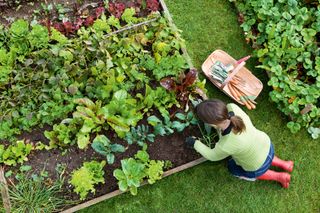
There's plenty of good reasons that organic gardening is great for your outdoor space, and probably no more than it makes the garden a safer space for children and pets to be.
However, some gardeners are a bit trepidatious about the concept of organic gardening, and the extra work that might be required to maintain a thriving garden without the use of undoubtedly helpful chemical treatments.
But how difficult is organic gardening really? And where do you begin when starting out with an organic garden? RHS gold medal-winning garden designer Rob Dwiar has all the information you need.
What is Meant by Organic Gardening?
Growing produce organically is centred around avoiding herbicides and pesticides, and being as natural as possible. It might sound like a daunting way to garden but it’s really not that difficult to do successfully.
(MORE: 11 Ideas to Make Your Garden More Eco-Friendly)
That said, it’s not without its challenges, but with some preparation, organic gardening can be an interesting and rewarding way to grow. And it’s a great way to get all the family involved and to create a safer place for pets, animals and children to roam and investigate.
What are the Main Challenges of Organic Gardening?
In the first instance, abandoning ‘traditional’ (and perhaps easy) gardening methods to go organic might appear enormously time-consuming. This may be the case, but as your interaction with your garden increases, so will knowledge, and with it an increase in efficiency. It might also feel more demanding, as herbicides no longer take care of weeds – that will be a manual task – but small changes in approach can make a big difference.
The best approach to weeds may well be taken just before beginning an organic garden venture. For example, covering areas using black membrane or sheets to exclude the light will prevent annual weeds from coming up, and keeping this on over more than one season should reduce perennial weeds drastically, too.
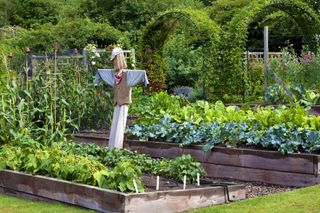
Deep layers of mulch (80mm or even 100mm) can also be preventative in a similar way. Otherwise, repeated manual removal through hoeing and forking can be effective at removing and eventually killing weeds, if a bit labour intensive.
(MORE: Garden Tools)
In the same way that natural mulch can help stave off weeds, natural ingredients can be used to feed plants, and therefore remove the potential use of pernicious chemical-based fertilisers. Well-rotted stable manure or chicken pellets used along with compost (easy to make in the garden from food waste) will cater for plants’ needs. This material can be dug in or spread on the soil in the winter months for the worms and weather to do the hard work.
Pest Control for Organic Gardens
Pests play a big part in gardeners’ trepidation towards organic gardening, but there are effective chemical-free methods of handling threats.
Barriers like chicken mesh over cabbage and root vegetables, and cages over berries or fruits will protect crops from birds.
However, birds can also help deal with aphids and sawfly caterpillars (which can devastate gooseberry and redcurrant crops) as well as any caterpillars and slugs, so their presence will have to be balanced against the fruit they will inevitably be interested in.
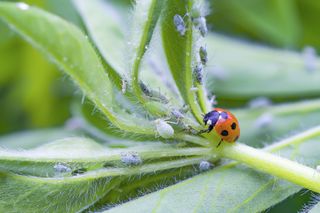
Covering fruit with a fleece in the weeks running up to harvest should foil fruit thieves. And introducing trouble-free plants like marigolds can be effective, as they will attract ladybirds, which can keep pests like aphids in check.
Alternatively, or perhaps in addition to physical methods, biological methods can be used. Generally, these are methods based on introducing natural predators that will prey on pests.
Use of these is very specific and timing is crucial, as introduced predators will need their prey active and alive; predators have very specific prey, and the type of predator is important per gardening situation.
What Should I Grow in an Organic Garden?
Essentially all plants can be grown organically so the options are endless, but here’s some ideas to start out with:
Fruit and vegetables
- Begin with: carrots, potatoes, onions, garlic, leeks, beans, berries.
- Work towards: Parsnips, celery, cauliflower, aubergine, asparagus, apples.
Ornamentals
- Begin with: Lawns, bulbs, choisyas, sedums, ferns, geraniums.
- Work toward: Dahlias, fuchsias, hydrangeas, clematis, box hedges, roses, pyracanthas (these harder options are susceptible to pests).
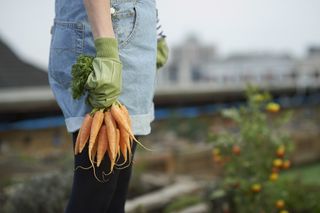
If you are new to organic gardening or a beginner gardener in general, grow ‘easy’ veg first – potatoes, carrots, beetroot, onions, peas, and beans – while avoiding more demanding crops like parsnip, celery and fennel. Root vegetables are excellent starters no matter your familiarity with organic gardening and they will be a solid barometer to tell you how well the patch and the implemented methods are performing.
Growing, preparing and planning can begin at any time; the age-old adage of ‘there’s always something to do in the garden’ certainly applies to organic gardening. As long as the soil is not too wet or cold, and can be worked without becoming compacted, it can be dug over and beds can be prepared, and some veg, like garlic, can be planted as late as December.
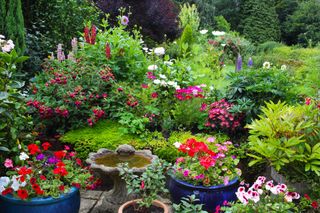
Organic gardening with produce can be incredibly rewarding and it may well be tempting to extend this to more ornamental plants. And, generally speaking, as long as a plant’s needs – its preferred climate, soil type, light and moisture requirements – are known and matched as closely as possible, then there is a decent chance of it prospering with little horticultural intervention.
Therefore, it is also wise to fit ideas around the desired plants and the conditions one’s plot can offer. If the plants grow healthily, then they have a good chance of withstanding pests but if the pests prevail a substitute will have to be found. This is gardening in a microcosm — one doesn’t know if something works until one tries.
Generally, however, many ornamental plants are looked after organically by default: lawns thrive without being sprayed; and removing slugs from hostas is an everyday gardening task.
What Type of Soil is Best for Organic Gardening?
It’s necessary to know the soil intimately. Be it sandy and free-draining, or heavy and thick clay, soil makes a big difference to any form of gardening and organic growing is no different.
Taking this a step further, find out if the soil is acidic, neutral or alkaline – it can be done via a simple testing kit – as it’s crucial in determining exactly which plants are compatible. And although it’s possible to adjust soil pH through feeding, it is always easier to match plants to the existing soil.
Clay soils are more retentive of water, so crops that have high water demands grow well in them — beans, brassica (cabbages) and peas. Veg that requires good drainage like beetroot and carrots, along with Mediterranean herbs (thyme, rosemary, sage, marjoram, chives) are a great fit for sandier soils.
Potatoes and peas, for example, are so easy going they will grow in any soil — even ‘builder’s soil’ homeowners are sometimes left with!
How to Start an Organic Garden
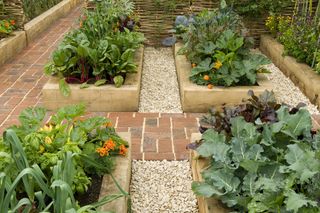
Begin by making sure there is enough space for your plot to grow effectively. You’ll need enough space to allow plants to thrive, ensure access to crops and enable light, water and air to circulate.
A raised veg bed will likely be best in the very first instance. And when working out its size, generally, you can work to the go-to materials’ dimensions – for example, sleepers are often 2.4m long and 200mm x 100mm, so a bed that’s 2.4m x 1.2m -
one whole sleeper by one half sleeper – will serve you very well.
Importantly, raised veg beds shouldn’t be wider than 1.5m, as you want to maintain easy access to crops in the middle. Getting the bed’s height to 300mm or more will provide the best chance for multiple crops, allowing plenty of soil and nutrients to be acquired as well as providing ample space to grow for larger fruit shrubs and root veg.
Knowing where the sun hits the garden is key, as well as knowing the direction of the prevailing wind, as these factors can all affect where to put your plot based on what you’d like to grow. Veg crops need as much light as you can give them; a good period of at least five hours a day of sunlight has been thrown around as a target.
Get the Homebuilding & Renovating Newsletter
Bring your dream home to life with expert advice, how to guides and design inspiration. Sign up for our newsletter and get two free tickets to a Homebuilding & Renovating Show near you.
Rob Dwiar is a RHS gold-medal winning landscape designer, alongside a writer focusing on gardens and video games.
